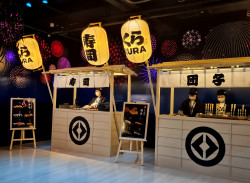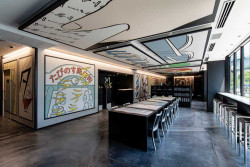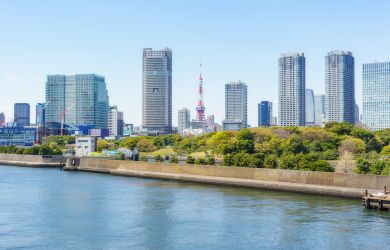
June 5, 2008
On the Move
Connecting Shibuya with Ikebukuro (finally!), Tokyo’s last major subway line is ready to roll. Hop onboard the nifty new Fukutoshin line
By Metropolis
Originally published on metropolis.co.jp on June 2008

Courtesy of Tokyo Metro Co.
More than 80 years after Tokyo’s first subway line opened between Asakusa and Ueno, the last major underground railway debuts as Tokyo Metro unveils the Fukutoshin line on June 14. First planned back in 1985, the Fukutoshin will travel 8.9 kilometers from Ikebukuro to Shibuya, with six stations in between. It connects with the Tobu Tojo, Seibu Yurakucho and Seibu Ikebukuro lines, and through service is planned with the Tokyu Toyoko line at Shibuya for 2012, completing a broad rail network linking southwestern Saitama with central Tokyo and Yokohama.
Being promoted under the dubious slogan of “Subways that harmonize with towns and are loved by people along the line,” the Fukutoshin (the name means “subcenter”) is the ninth subway line to be operated by Tokyo Metro Co Ltd, which currently carries 5.9 million passengers a day along 195.1 kilometers of track via 179 stations. By comparison, the city’s other subway system, the metropolitan government-run Toei network, transports 2.03 million passengers daily and has 109 kilometers of track and 106 stations on its four lines.
Construction began in 2001 on what, until recently, was referred to as Line No. 13. “We decided on the name of the line by asking employees for suggestions. In prior cases, we sometimes carried out a public campaign,” says Tatsuya Edakubo, a spokesman for Tokyo Metro. Fukutoshin will be the last line that Tokyo Metro will open, Edakubo says, because the Council for Transportation Policy is convinced that the city is now well covered by subways. Toei, on the other hand, is planning to add to the Mita and Oedo lines by 2015.
For Tokyo Metro, the opening of the Fukutoshin line ends an 80-year journey. Tokyo’s first subway opened on December 30, 1927, by the government. The Teito Rapid Transit Authority was established in 1941, and since then it has overseen the extension of the original Ginza line and the construction of seven other routes: Marunouchi, Hibiya, Tozai, Chiyoda, Yurakucho, Hanzomon and Namboku. In 2004, the authority was transformed into a company called Tokyo Metro, its first step toward privatization.
Building a new subway line is not cheap when you consider how deep some stations are. The deepest station on the Fukutoshin line is Higashi-Shinjuku, at 35 meters (Roppongi on the Oedo line is Tokyo’s deepest station, at 42.3 meters). Construction can cost up to ¥247 billion per kilometer. Most of the civil engineering costs on the Fukutoshin line—tunnels and infrastructure—are being subsidized by the national and Tokyo metropolitan government’s highway toll system.
Edakubo explains that when a new line is planned, the first step is deciding where the stations will be. “The locations are part of the council’s plan, although each ward office has a say. The same applies to the name of the station.” Before construction can begin, the area is surveyed for historical relics in accordance with the Law for the Protection of Cultural Properties. The area near Zoshigaya station, for example, has turned up relics dating back hundreds of years, among them sake containers and ceramic pots and containers.
Six of the stations along the Fukutoshin line lie beneath Meiji Dori, which will ease traffic congestion on that artery, and be particularly convenient if Tokyo is successful in its 2016 Olympic bid, since many events will be held in that area. From Shibuya, the line passes through Meiji-Jingumae, Kitasando, Shinjuku-Sanchome, Higashi-Shinjuku, Nishi-Waseda and Zoshigaya before reaching Ikebukuro.
“Trains will run every three minutes, 35 seconds during rush hour, and every five minutes at other times,” says Edakubo. Rush hour congestion remains a big headache for commuters. “On the Fukutoshin line, trains will have ten cars and eight when it becomes the through service with the Toyoko line from Shibuya. That’s because some of the stations on the Toyoko line can only accommodate eight cars. With our other lines, all have ten cars…”

Courtesy of Tokyo Metro Co.
Tokyo Metro operates women-only cars on the Hibiya, Tozai, Chiyoda, Yurakucho and Hanzomon lines, but Edakubo says we’ll have to wait for them to arrive on the new railway. “Eventually we will have women-only cars on the Fukutoshin line, but not right away. We don’t know which cars they will be yet because when we have through services, we have to accommodate other rail companies and their policy on the issue.”
Such through services are among the most efficient features of Tokyo’s subway. The first was created on the Hibiya line just prior to the Olympic Games in 1964. Commuting in the Kanto region became even more hassle-free last year with the introduction of Pasmo, an IC card that can be used on most private rail companies, subways and buses.
With the decision not to build any more lines, Edakubo says Tokyo Metro will concentrate on improving its facilities. All stations on the Fukutoshin line will offer wireless LAN services, as well as barrier-free access and Braille vending machines. The platforms have half-height doors to prevent people accidentally falling off due to overcrowding (and suicides). The ceilings on the Fukutoshin are much higher than at other stations—Shinjuku-Sanchome even has a mezzanine floor overlooking the platform. At Ikebukuro, Tokyo Metro plans to open a dining and shopping complex similar to the one at Omotesando, said Edakubo.
For anyone interested in the details of how a subway is constructed, the Fukutoshin Line Construction Office has built an exhibition hall at Shinjuku-Sanchome station. Showcases include a diorama of the Fukutoshin line, construction machinery models and explanations of how tunneling is done and what happens to all the soil and slurry dug up.







